From the vast plains of eastern Colorado to the dramatic mountain peaks in the Rocky Mountain range, and its unique wildlife inhabitants, Colorado is home to some of the most breathtaking and diverse natural wonders in the world. This state comes with an almost overwhelming selection of distinctive plants and trees that can be admired and cultivated. From small shrubs to majestic trees, there is something for any taste imaginable!
Colorado experiences harsh snowy winters, so many plants die in the winter and come back in the spring and summer months. With over 3,000 native plants in Colorado, it can be tough to know where to even begin when learning about the botany of the state. So keep reading to discover a small selection of the various indigenous plants the Centennial State has to offer.
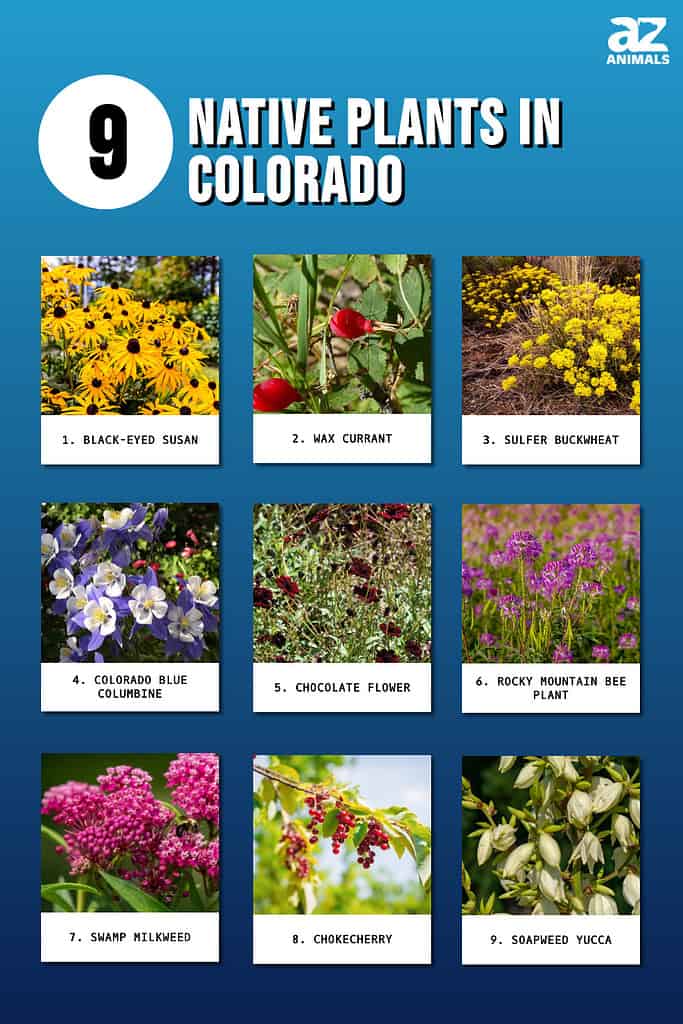
1. Black-Eyed Susan (Rudbeckia hirta)
The black-eyed Susan, or Rudbeckia hirta, is a beautifully bright and vibrant flower that is native to several areas of the United States, including Colorado.
Each flower grows up to 3 feet tall and has bright yellow petals with a dark black center. So, having a few of these in your garden is sure to create an eye-catching feature!
This flower thrives in full sunlight, and it will typically bloom in the summer or early fall. They also have low water requirements, making them fairly low maintenance. While generally considered an annual flower, they can sometimes continue blooming into a second year if cultivated properly.
The black-eyed Susan is a hardy flower that can survive in a wide variety of different climates, provided it gets the sunlight it needs. Not only that, but its bright yellow petals and black center make for a stunning flower.
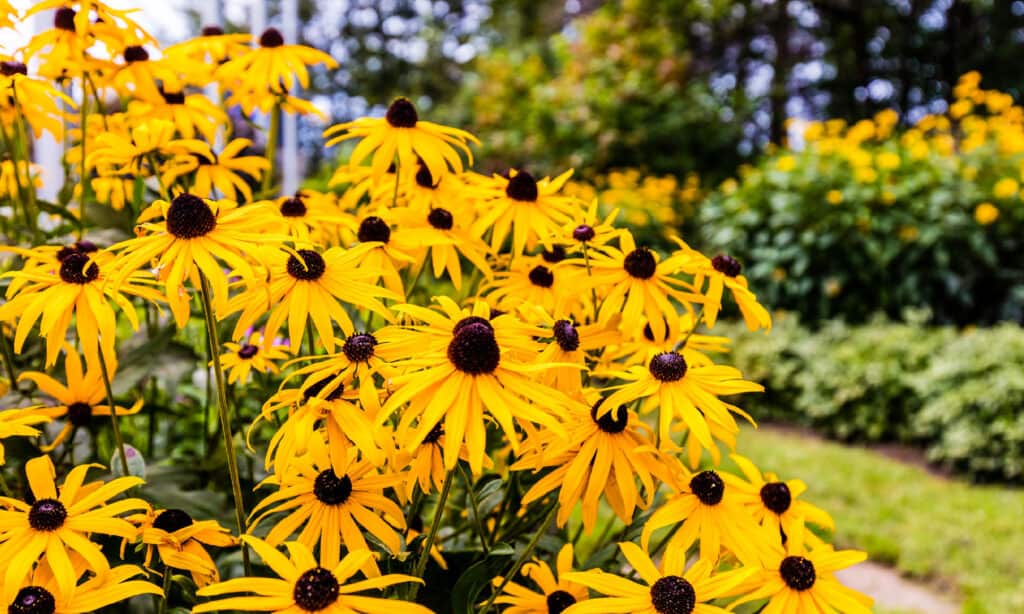
The black-eyed susan is a vibrant flower that thrives in full sunlight.
©iStock.com/Dopeyden
2. Wax Currant (Ribes cereum)
The wax currant is another plant that can be found in many different parts of the United States, including Colorado. Considered a perennial shrub, the wax currant can take up a fair amount of space, as it can grow up to 5 feet tall.
There is a delicate beauty to this plant. It starts with gorgeous light pink bulbs in early spring that will then grow into the small red currants that give the plant its name.
These berries are edible, but their lack of taste makes them better suited for wildlife to feed on. They typically bloom between April and July, and they don’t require a lot of water.
With decent sunlight exposure and drained soil, you can expect wax currants to thrive.

Wax currant starts with gorgeous light pink bulbs in early spring that will grow into small red currants.
©ForestSeasons/Shutterstock.com
3. Sulfer Buckwheat (Eriogonum umbellatum)
When it comes to sulfur buckwheat, variety is the name of the game. This perennial herb comes in many varieties, making properly identifying it a bit of a challenge.
The word “sulfur” doesn’t conjure pleasant associations, but this plant is bright and vibrant with its stunning yellow flowers.
Sulfur buckwheat will typically flower between April and September and is hardy enough to survive some less-than-ideal conditions. You’ll want to ensure this plant has full sun exposure, but you don’t need to worry about keeping it well watered, as it can survive in drier soil.

Sulfur buckwheat is hardy enough to survive some less-than-ideal conditions.
©iStock.com/Jeremy Francis
4. Colorado Blue Columbine (Aquilegia caerulea)
It doesn’t get more Colorado than the gorgeous Colorado blue columbine! Not only is the state mentioned in the name, but it also happens to be the state flower of Colorado.
Considered a short-lived perennial flower, the blue columbine may have a shorter lifespan, but it compensates with the ability to self-seed.
When cultivated properly, you can expect this beautiful flower to form large colonies that are sure to catch your eye. If you wish to grow some of your own, you’ll want to ensure they get plenty of sunlight with moist soil.
The Colorado blue columbine is a fairly resilient flower that can also persist on its own with relative ease. There is no wonder this is the state flower with its gorgeous white and blue petals. The Colorado blue columbine will also be sure to attract birds and insects such as butterflies.
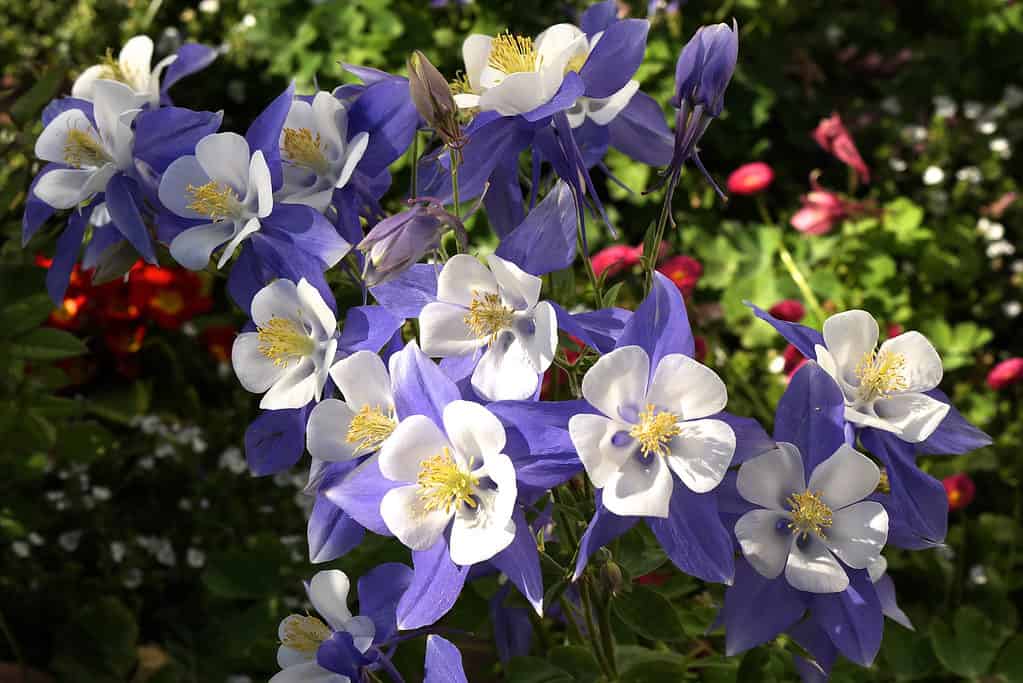
The Colorado blue columbine is the state flower of Colorado.
©iStock.com/Linda Jo Heilman
5. Chocolate Flower (Berlandiera lyrata)
A flower that smells like chocolate seems too good to be true, but the chocolate flower isn’t false advertising!
This incredible plant not only catches the eye with its daisy-like structure and bright yellow petals, but the leaves also provide the flower’s namesake as they have a distinct chocolate aroma.
This fairly low-maintenance perennial requires decent amounts of sunlight and water, and it has a reasonably large bloom period, ranging from April to November. However, it can also thrive in more arid, low moisture conditions, making it an excellent low-maintenance addition to a garden.

The chocolate flower’s leaves have a distinct chocolate aroma.
©Manfred Ruckszio/Shutterstock.com
6. Rocky Mountain Bee Plant (Cleome serrulata)
The Rocky Mountains are known as one of the most impressive natural wonders in the world, and the Rocky Mountain bee plant more than earns the right to share a name with this famous mountain range.
Growing up to 5 feet tall, these plants can create large colonies of breathtaking flowers that are a wonder to behold. While they may not have the most inviting aroma, these flowers were commonly used by Native American tribes for medicinal purposes.
Their practical uses, along with their beauty, make them an attractive feature wherever they appear.
The Rocky Mountain bee plant is an annual plant that blooms between May and September. Full sunlight and water will make this beautiful plant grow splendidly!
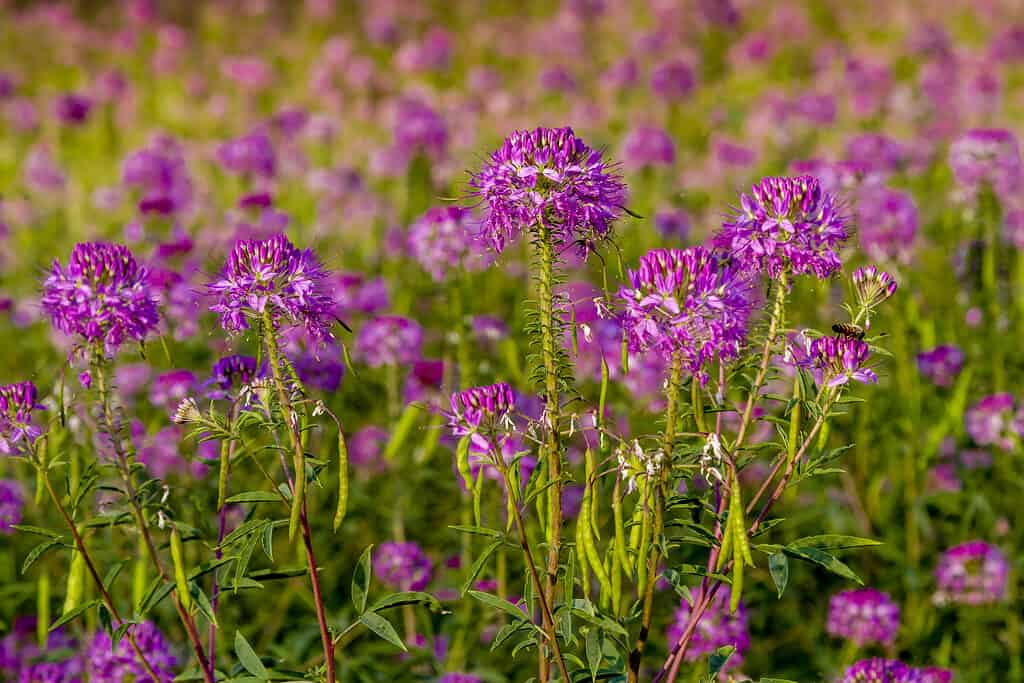
The Rocky Mountain bee plant’s flowers were commonly used by Native American tribes for medicinal purposes.
©Teri Virbickis/Shutterstock.com
7. Swamp Milkweed (Asclepias incarnata)
So far, we have covered a few plants with some pretty evocative names. The swamp milkweed conjures up less enticing images, however.
While it may not have the prettiest name, it more than makes up for it with its appearance. With its clusters of delicate pink buds and the potential height of up to 5 feet, this plant creates a prettier sight than its name would have you expect.
This herb is a perennial that functions as an excellent food source for insects and wildlife. Humans should be wary, as they can be poisonous if eaten raw. However, when prepared properly, they can be safely consumed.
They can also be toxic to various animals, so this is worth keeping in mind if you have pets and wish to grow this plant on your property.
These herbs will need plenty of water, and you can expect them to bloom between June to October. As the name suggests, they thrive in swampy environments or locations with plenty of moisture.

Swamp milkweed has clusters of delicate pink buds with nectar that can attract
bees
and butterflies.
©iStock.com/Cynthia Shirk
8. Chokecherry (Prunus virginiana)
Next, we have another plant with a bit of an unfortunate name. However, once again, the look of this plant makes up for its title, as it has some beautifully delicate white flowers.
These flowers will then turn into the dark red cherries that give this plant its name. As you can imagine from this name, the cherries are quite bitter and not recommended for raw consumption.
They can be prepared for use in various preserves and recipes, but they also form a valuable food source for the local wildlife.
The chokecherry can grow in thickets that can reach 30 feet tall, classifying it as a tree or shrub. You can expect it to bloom between April and July, and it typically requires medium sunlight with low levels of water and soil moisture.

Chokecherry trees produce dark red berries and can reach up to 30 feet tall.
©iStock.com/Elenakirey
9. Soapweed Yucca (Yucca glauca)
The soapweed yucca grows in a very different climate than most of the other plants on this list. They are perennial plants that thrive in dry, arid conditions. In other words, they do not need much water or moisture but prefer plenty of sunlight.
The plant presents clumps of delicate white bell-shaped bulbs with pretty green leaves.
While they are beautiful flowers in their own right, they also have a few practical uses. This plant has various medicinal benefits when prepared properly, and it can even be used to create natural soaps.
There is certainly more than meets the eye when it comes to this plant, and it will also attract butterflies that will add further beauty to the environment you place them in!
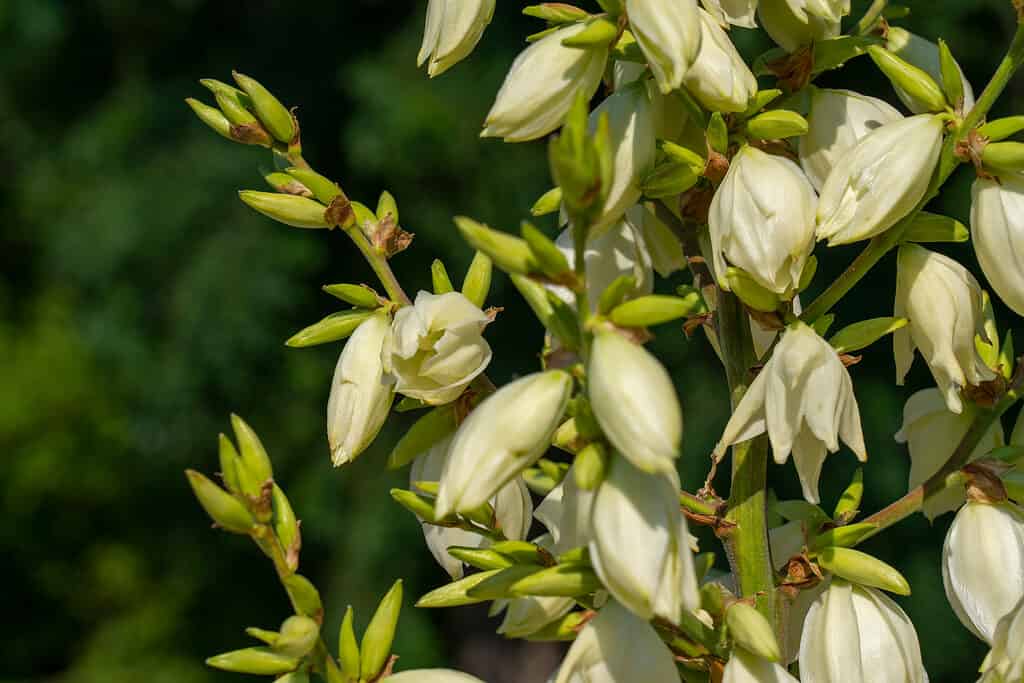
Soapweed Yucca produces clumps of delicate white bell-shaped bulbs with pretty green leaves.
©martin.dlugo/Shutterstock.com
Summary of 9 Native Plants in Colorado
Here’s a recap of the nine plants we looked at that are native to the state of Colorado.
| Number | Plant | Scientific Name | Type of Plant |
|---|---|---|---|
| 1 | Black-Eyed Susan | Rudbeckia hirta | Annual |
| 2 | Wax Currant | Ribes cereum | Perennial shrub |
| 3 | Sulfer Buckwheat | Eriogonum umbellatu | Perennial herb |
| 4 | Colorado Blue Columbine | Aquilegia caerulea | Perennial flower |
| 5 | Chocolate Flower | Berlandiera lyrata | Perennial |
| 6 | Rocky Mountain Bee Plant | Cleome serrulata | Annual |
| 7 | Swamp Milkweed | Asclepias incarnata | Perennial |
| 8 | Chokecherry | Prunus virginiana | Shrub or tree |
| 9 | Soapweed Yucca | Yucca glauca | Perennial |
The photo featured at the top of this post is © Glenn W. Wheeler/Shutterstock.com
Sources
- Uncover Colorado, Available here: https://www.uncovercolorado.com/native-colorado-landscaping-plants/
- Backyard Garden Lover, Available here: https://www.backyardgardenlover.com/colorado-native-plants-list/
- Britannica, Available here: https://www.britannica.com/plant/black-eyed-Susan-plant
- Almanac, Available here: https://www.almanac.com/plant/black-eyed-susans
- Chelan Douglas Land Trust, Available here: https://www.cdlandtrust.org/trails-access/field-guide/wax-currant
- Gardenia , Available here: https://www.gardenia.net/plant/eriogonum-umbellatum
- Southwest Desert Flora, Available here: http://southwestdesertflora.com/WebsiteFolders/All_Species/Polygonaceae/Eriogonum%20umbellatum,%20Sulphur-Flower%20Buckwheat.html
Thank you for reading! Have some feedback for us? Contact the AZ Animals editorial team.






